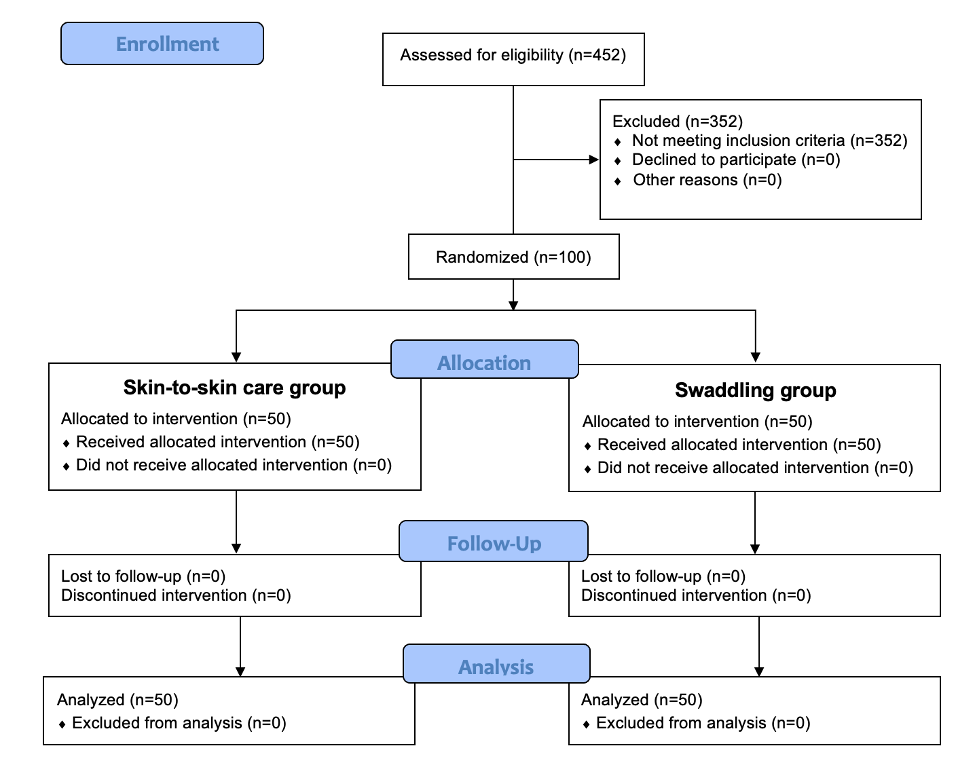Neonatal Neurology: Clinical
Category: Abstract Submission
Neurology 4: Neonatal Neurology Preterm Clinical
464 - Efficacy of Skin-To-Skin Care Versus Swaddling for Pain Control in Term Newborns Immediately after Birth: A Randomized Controlled Trial
Sunday, April 24, 2022
3:30 PM - 6:00 PM US MT
Poster Number: 464
Publication Number: 464.342
Publication Number: 464.342
Vivek V. Shukla, University of Alabama at Birmingham, Birmingham, AL, United States; Sarthak N. Soni, Shree Krishna hospital, Anand, Gujarat, India; Ajay G. Phatak, Bhaikaka University, Karamsad, Anand, Gujarat, India; MAYUR SHINDE, BHAIKAKA UNIVERSITY, Anand, Gujarat, India; Archana S. Nimbalkar, Bhaikaka University, Karamsad, Gujarat, India; Somashekhar M. Nimbalkar, Bhaikaka University, Karamsad, Gujarat, India; Dipen V. Patel, Bhiakaka University, Karamsad, Gujarat, India

Vivek Shukla, MD (he/him/his)
Assistant Professor
University of Alabama at Birmingham
Birmingham, Alabama, United States
Presenting Author(s)
Background:
As several physiological changes occur at birth, the efficacy of interventions in the immediate postnatal period could be different.
Objective: The objective of this trial was to test the hypothesis that skin-to-skin care is more efficacious than swaddling for pain control in term newborns at 30 minutes after birth.
Design/Methods: Term newborns were screened and enrolled in the study after birth and were randomly assigned (1:1) to either skin-to-skin care (SSC) or swaddling for pain control related to routine intramuscular vitamin K injection administered at 30 minutes after birth. Neonatal Infant Pain Scale (NIPS) was measured at baseline (immediately before), immediately after, and 2-minutes after the procedure. Group comparisons were made by either independent sample t-test, paired t-test, or Fischer exact t-test as pertinent.
Results: A total of 100 (50/group) newborns were enrolled in the study. Baseline characteristics were comparable between the groups. Mean (SD) of the NIPS score was comparable between the SSC and swaddling group at baseline [1.78 (0.58) vs. 1.96 (0.83), respectively, p=0.21], and immediately after the procedure [4.82 (0.72) vs. 5.08 (0.75), respectively, p=0.08]. NIPS score at 2-minutes after the procedure was significantly lower in the SSC group [1.38 (0.69) vs. 2.88 (1.00), respectively, p< 0.01]. A significantly higher proportion of newborns had a NIPS score >3 at 2-minutes after the procedure in the swaddling group [1 (2%) vs. 11 (22%), respectively, p< 0.01].Conclusion(s):
This randomized control trial compared the efficacy of skin-to-skin care vs. swaddling for pain control in term newborns at 30 minutes of birth and found that skin-to-skin care was more efficacious for pain control than swaddling. Future studies could assess the efficacy of study interventions in preterm newborns as well as in combination with other pain control interventions.
Figure 1: Participant Flow Diagram
Table 1: Baseline Characteristics
As several physiological changes occur at birth, the efficacy of interventions in the immediate postnatal period could be different.
Objective: The objective of this trial was to test the hypothesis that skin-to-skin care is more efficacious than swaddling for pain control in term newborns at 30 minutes after birth.
Design/Methods: Term newborns were screened and enrolled in the study after birth and were randomly assigned (1:1) to either skin-to-skin care (SSC) or swaddling for pain control related to routine intramuscular vitamin K injection administered at 30 minutes after birth. Neonatal Infant Pain Scale (NIPS) was measured at baseline (immediately before), immediately after, and 2-minutes after the procedure. Group comparisons were made by either independent sample t-test, paired t-test, or Fischer exact t-test as pertinent.
Results: A total of 100 (50/group) newborns were enrolled in the study. Baseline characteristics were comparable between the groups. Mean (SD) of the NIPS score was comparable between the SSC and swaddling group at baseline [1.78 (0.58) vs. 1.96 (0.83), respectively, p=0.21], and immediately after the procedure [4.82 (0.72) vs. 5.08 (0.75), respectively, p=0.08]. NIPS score at 2-minutes after the procedure was significantly lower in the SSC group [1.38 (0.69) vs. 2.88 (1.00), respectively, p< 0.01]. A significantly higher proportion of newborns had a NIPS score >3 at 2-minutes after the procedure in the swaddling group [1 (2%) vs. 11 (22%), respectively, p< 0.01].Conclusion(s):
This randomized control trial compared the efficacy of skin-to-skin care vs. swaddling for pain control in term newborns at 30 minutes of birth and found that skin-to-skin care was more efficacious for pain control than swaddling. Future studies could assess the efficacy of study interventions in preterm newborns as well as in combination with other pain control interventions.
Figure 1: Participant Flow Diagram

Table 1: Baseline Characteristics

